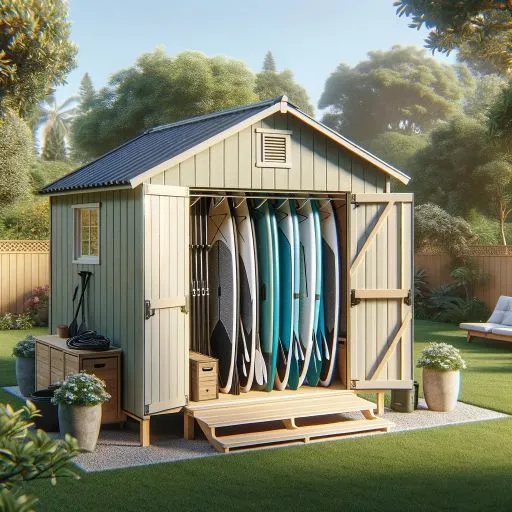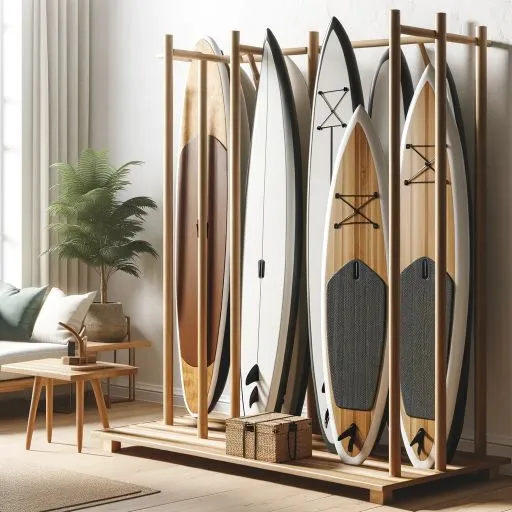Paddle boarding is more than a sport—it’s a passion that combines adventure, relaxation, and a full-body workout. However, taking care of your paddle board is crucial to ensure it lasts for many seasons to come. Proper storage is not just about saving space; it’s about protecting your investment from damage and wear. This guide will walk you through the process of how to store paddle boards and tips to keep your paddle board safe and ready for your next outing.
The Importance of Proper Storage
Storing your paddle board correctly can prevent warping, delamination, and other forms of damage. It also makes it easier to grab your board and hit the water whenever the mood strikes. Whether you have a solid or inflatable board, the right storage solutions can extend the life of your board and accessories.
Overview of Storage Solutions
There are many ways to store a paddle board: wall racks, ceiling hoists, freestanding racks, and outdoor options. This article will explore the benefits and considerations of each, providing you with the knowledge to choose the best storage solution for your needs.
Factors to Consider Before Storing Your Paddle Board

Before selecting a storage method, consider the following factors:
Space Availability
Assess the space you have at home or in your garage. Measure the dimensions of your board and compare them to the available space to ensure a good fit.
Environmental Conditions
Consider the climate you live in. If you experience extreme temperatures or high humidity, you’ll need to find a storage solution that protects your board from these conditions.
Accessibility
Think about how often you use your paddle board. If you’re a frequent paddler, you’ll want a storage option that allows for easy access.
Preparing Your Paddle Board for Storage
Cleaning and Drying
Before storing your paddle board, it’s essential to clean it thoroughly with freshwater, especially if you’ve been paddling in saltwater. Dry it completely to prevent mildew and water damage.
Repairs and Maintenance
Inspect your board for any dings, scratches, or repairs that need attention. Addressing these issues before storage will ensure your board is ready to go for your next session.
Deflating (If Inflatable)
If you have an inflatable paddle board, deflate it according to the manufacturer’s instructions. This will prevent any stress on the seams and material.
Indoor Storage Solutions
Indoor storage is generally the best option to protect your paddle board from the elements.
Wall Racks: Maximizing Space Efficiency
Wall racks are a popular choice because they use vertical space, which is often under-utilized.
Selecting the Right Wall Rack
Choose a rack that can support the weight and length of your board. Padding on the rack can provide extra protection.
Installation Tips
Ensure that the rack is securely mounted to wall studs to handle the weight of the board.
Ceiling Racks: Utilizing Unused Space
Ceiling racks can be great for storing multiple boards and can be lowered or raised with ease.
The Benefits of Ceiling Storage
Ceiling racks keep boards out of the way and can be an excellent option for those with limited wall space.
Step-by-Step Installation Guide
Installing a ceiling rack typically involves securing it to ceiling joists and ensuring that the hoist system works smoothly.
Free-Standing Racks: Flexible and Portable Options
For paddlers who prefer not to mount racks to walls or ceilings, free-standing racks are an excellent alternative.
Advantages of Free-Standing Solutions
They are portable, easy to set up, and can be moved as needed.
Setup and Safety Tips
Choose a stable area of your home and consider securing the rack to prevent tipping.
DIY Solutions: Building Your Own Storage System

For the hands-on individual, creating a custom storage solution can be a rewarding project.
Materials You Will Need
Gather supplies such as lumber, screws, and padding material.
Constructing a Simple Rack
You can build a rack that fits your specific space and board dimensions. Simple designs can be just as effective as purchased ones.
Outdoor Storage Solutions
If indoor space is not an option, there are ways to safely store your board outside.
Protective Covers: Shielding from the Elements
A good cover can protect your board from UV rays, rain, and snow.
Types of Covers and Their Features
Look for covers that are waterproof and UV-resistant.
Correct Cover Usage
Make sure the cover fits snugly around your board and is secured properly.
Outdoor Racks: Durable and Secure
Outdoor racks should be constructed from materials that can withstand the weather.
Choosing a Weather-Resistant Rack
Opt for stainless steel or treated wood racks that resist rust and decay.
Security Measures to Consider
Invest in a good lock and, if possible, position the rack within sight to deter theft.
Utilizing Sheds and
Storage Units
Storing your board in a shed or storage unit can provide additional protection from the elements.
Preparing an Outdoor Shed for Board Storage
Make sure the shed is clean, dry, and free from pests.
Balancing Accessibility with Protection
While sheds can offer great protection, ensure your board is still easily accessible for spontaneous paddling sessions.
Seasonal Considerations
Winter Storage: Battling the Cold
Cold temperatures can be harsh on boards, so indoor storage is preferable in winter.
Insulation and Temperature Control
If the board must be stored in a shed or garage, consider insulation to protect it from freezing temperatures.
Special Considerations for Inflatable Boards
Inflatables should be stored partially inflated in a temperature-controlled environment.
Summer Storage: Preparing for Frequent Use
During the summer, you’ll want your board to be readily accessible.
Quick-Access Solutions
Outdoor racks or easy-to-use wall racks are ideal during the paddling season.
Protection from Sun Damage
Even in summer, protect your board from prolonged sun exposure when not in use.
Maintenance During Storage
Periodic Checks
Regularly check on your board to ensure it remains in good condition, even when not in use.
Long-Term Storage Considerations
If storing your board for an extended period, consider a thorough inspection and possibly storing it in a bag or cover to protect it from dust and dirt.
Conclusion
Storing your paddle board properly will extend its life and ensure it’s always ready for your next water adventure. By considering the factors outlined and following the tips provided, you can choose the best storage solution for your needs. Remember to clean, maintain, and inspect your board regularly, and you’ll enjoy many years of paddling fun.

Meet Hudson, an enthusiastic writer and the Chief Editor at Outdoor Bravo Blog. Hudson’s heart belongs to the world of kayaking and kayaks, fueled by his insatiable love for nature and adventure.
